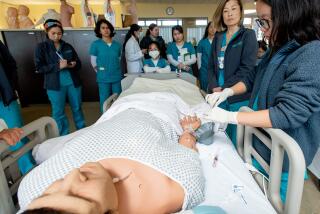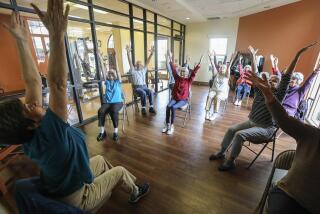Nurse deficit afflicts state
Nicole Oswell was a straight-A student passionately interested since first grade in following in her mother’s footsteps as a registered nurse. But she had to wait two years to get into Los Angeles Trade Tech’s nursing program, she said, her frustration mounting as national nursing shortages worsened.
Lizbeth Gutierrez got lucky. Her wait was only six months. But that’s because she won a lottery for a space at East Los Angeles College, one way that nursing schools overwhelmed with applicants now select students. There are currently 17,000 qualified California applicants waiting to enter nursing programs and more than 130,000 in other states.
As nationwide nursing shortages threaten to balloon to more than 1 million over the next several years, healthcare organizations are grappling with a range of problems, including how many foreign nurses to import, how to increase spaces at overcrowded nursing schools and how to make sure that students allowed in the programs complete them.
Some are lobbying for larger quotas for foreign nurses. But many experts -- and aspiring nurses themselves -- are also urging policymakers to expand opportunities for Americans clamoring to become nurses.
“Just the waiting list alone tells you there are tons of people here who want to be nurses,” said Oswell, a 25-year-old Minnesota native. “We should give the people who live here the opportunities for those jobs.”
With growing urgency, policymakers are aiming to do just that with a flurry of initiatives to accommodate more California nursing students. This week, the Los Angeles County Board of Supervisors is set to accept a $3-million grant from L.A. Care Health Plan to open a new nursing program at Olive View-UCLA Medical Center.
Last week, the California Wellness Foundation sponsored a media tour of an East Los Angeles medical clinic and two educational institutions to highlight the shortage of healthcare workers and encourage more young people, particularly minorities, to consider the profession. The foundation said 51 of California’s 58 counties are facing shortages of workers in nearly 200 allied health professions.
UCLA reopened its undergraduate nursing program last year after a 10-year hiatus, and several medical centers are partnering with other colleges to increase nursing school spots. In the San Fernando Valley, for instance, seven hospitals and five community colleges are collaborating on a two-year, $1.8-million pilot project to produce 100 more slots for nurses.
Gov. Arnold Schwarzenegger, meanwhile, launched a three-year, $90-million initiative in 2005 with public and private partners to expand nursing schools throughout the state.
The debate over nursing highlights the perennial question of whether to import foreign workers or take steps to better attract and train Americans to fill the demand. That debate is heightened now with two major immigration bills pending in Congress that would take dramatically different approaches to the nursing question.
The Senate bipartisan immigration bill, which was sidelined last week, would make it “nearly impossible for foreign nurses to immigrate to the U.S.,” said Los Angeles immigration attorney Carl Shusterman.
The bill’s proposed point system for selecting immigrants favors those with advanced education and skills, he said, but relatively few nurses have graduate degrees. Only a two-year associate’s degree is required for registered nurses, and community colleges graduate nearly two-thirds of California’s nurses. And the U.S. Labor Department does not consider the nursing profession a specialty occupation that wins extra points, Shusterman said.
In contrast, the House immigration bill by Reps. Jeff Flake (R-Ariz.) and Luis V. Gutierrez (D-Ill.) would allow the unlimited entry of foreign nurses for 10 years.
Many experts say, however, that both foreign and American nurses are badly needed because of a shortage that demographers and labor experts predict will worsen over time as baby boomers retire and the nursing workforce ages.
“It’s not either/or,” said Shusterman, whose law firm has helped 6,500 foreign nurses immigrate here, mostly from the Philippines, over the last two decades. “The nursing shortage is so bad that you really have to have both.”
The nursing profession was battered during the 1990s by the advent of managed care and cost-cutting, which prompted many hospitals to reduce registered nursing staffs and increase workloads. Many nurses left the field and colleges began cutting back their nursing programs.
But as nursing shortages developed, the tide began to turn in the late 1990s and early 2000. Gov. Gray Davis signed into law the nation’s first mandated nurse-patient ratios in 1999, which essentially halved patient loads on the busy medical-surgical floors, according to the California Nurses Assn.
Meanwhile, employers began raising pay. Average annual salaries for full-time registered nurses have increased to about $69,000 in 2006 from $52,000 in 2000, a 32% gain, according to a May study by the state legislative analyst’s office.
The rising pay and improved working conditions have attracted thousands of students to the nursing field. But a bottleneck has developed. The average wait to enter nursing school is now two to three years, primarily because of a shortage of classroom space and nursing educators, who can make more money in hospitals than schools.
Worsening the problem, 25% of those who are admitted to community college nursing programs drop out and another 25% do not graduate on schedule, the legislative analyst’s office found. The attrition rate is far higher than for University of California and California State University students; experts believe it is caused in part by the community colleges’ admissions process, which uses lotteries or first-come, first-served selection methods rather than strictly academic merit.
Gutierrez, for example, said half or more of her entering class of 70 students have struggled academically and been held back or dropped out of the program entirely. She defended the lottery system, however, saying it opened nursing to a broader range of students.
State community colleges abandoned the academic merit system in 1988 after the Mexican American Legal Defense and Educational Fund sued them for disproportionately excluding Latino students. Even today, however, the nursing workforce in California remains predominantly white, with 22% Asian American, 6% Latino and 4% African American.
Several organizations are mobilizing to improve those numbers, as research shows that a community’s health improves when those who deliver the medical care reflect its demographics, experts say.
“I personally don’t think it takes an A student to be a good nurse,” said Gutierrez, who described herself as a B student with fluent Spanish and a good bedside manner. “It’s the heart.”
Hospitals, meanwhile, have also heavily relied on foreign nurses to fill the shortfall.
Foreign nurses in the United States have grown from 5% of newly licensed registered nurses in 1997 to 14% in 2003, according to a study published last year by Paul F. Clark, a Penn State University labor professor, and two colleagues. In California, they make up about 18% of the state’s 230,000 registered nurses.
But some health professionals worry about the ethics of affluent nations like the U.S. depriving poorer countries of badly needed medical professionals. Most nations are currently suffering nursing shortages, including 30,000 vacancies in the Philippines, according to Clark.
“It’s a real ethical dilemma,” Clark said. “Nurses in developing countries have every right to immigrate for a better life.... But by going into a developing country and actively recruiting, you end up having a very adverse effect on countries that are very poor and marginal.”
In any case, few believe that foreign nurses are the best answer to America’s mounting medical needs.
“In the interim, do we need them?” asked Jan Emerson, spokeswoman for the California Hospitals Assn., referring to foreign nurses. “Absolutely we do. But it’s a Band-Aid on the bigger problem. We as a state and country have to fix the problem by putting enough resources into the education system to produce the nurses we need.”
One local hospital trying to do just that is Downey Regional Medical Center. The hospital has deliberately decided against relying on foreign nurses and instead produces its own nurses through partnerships with two community colleges.
Heather Conwell, Downey’s chief nursing officer, said the hospital’s experiences with foreign nurses weren’t ideal. Several Filipino doctors retrained as nurses couldn’t quite make the transition, she said, and a pair of Canadian nurses quit in mid-contract because, the hospital was told, Downey wasn’t “close enough to the beach.”
Downey now pays one of its nurses to teach at Cerritos College and contributes to a nursing student scholarship with the East Los Angeles Community Union at East L.A. College. In exchange, the hospital is able to hire 45 new nurses from the two campuses each year, asking for a one- to two-year commitment.
“We found we get a bigger bang for the buck with these two strategies,” Conwell said. “We serve a Hispanic population, but very few international nurses speak Spanish. By recruiting in East L.A., we also get nurses who are culturally sensitive to our population.”
That includes young women like Gutierrez, a 22-year-old Fresno native who distributes meal trays and performs other jobs as a student worker at Downey. She plans to apply for the hospital’s scholarship to help her finish nursing school.
Gutierrez was first exposed to nursing by her mother, who worked in the field in Mexico for 20 years. But it was a personal experience with caring nurses during her gallbladder surgery five years ago that clinched her decision to enter the field.
Gutierrez said her mother also wants to return to nursing but hasn’t yet passed the U.S. licensing exams.
If her mother, now a U.S. citizen, could win a little financial help to pay for a review course, Gutierrez said, that would be one more nurse to help fill the shortage.
“It doesn’t make sense to help foreign nurses come here, when we can help our own,” she said.
More to Read
Sign up for Essential California
The most important California stories and recommendations in your inbox every morning.
You may occasionally receive promotional content from the Los Angeles Times.











